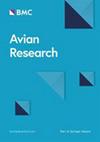夜间照明对鸟类认知功能的影响:涉及神经变性、代谢失调和神经炎症反应的机制
IF 1.7
2区 生物学
Q1 ORNITHOLOGY
引用次数: 0
摘要
城市化的快速发展导致野生鸟类广泛暴露于夜间强光下。虽然以前的研究已经确定了lan引起的鸟类认知障碍,但潜在的神经生物学机制仍然知之甚少。我们假设LAN暴露可能通过端脑的神经变性、代谢失调和神经炎症反应损害鸟类的认知功能。以斑胸草雀(Taeniopygia guttata)为鸟类模型,在16L:8D光周期下,比较了夜间昏暗(LAN)和夜间黑暗(CTR)条件下各组的联想学习记忆能力和神经生物学参数。与CTR组相比,lan暴露组的学习和记忆能力明显下降,远脑区神经元密度降低,树突形态简化。lan暴露的鸟类远脑内的关键能量代谢底物(胆酸、CTP、d -甘露糖-6-磷酸)和神经保护剂(海藻糖、甲基萘醌、l -古洛诺-1,4-内酯)呈耗竭状态,氧化应激标志物(蛋氨酸亚砜)和炎症介质(顺式性腺酸)呈升高状态。神经递质多巴胺和组胺代谢途径在lan暴露的鸟类中被破坏。lan暴露的鸟类端脑小胶质细胞被激活,促炎IL-1β和IL-6水平升高,抗炎IL-10水平降低。这些发现提示了一种潜在的机制途径,即夜间昏暗的光照射可以通过氧化应激介导的小胶质细胞激活、能量代谢和神经递质稳态破坏诱导神经炎症,最终导致鸟类端脑的神经变性。本文章由计算机程序翻译,如有差异,请以英文原文为准。
Effects of night lighting on avian cognitive function: Mechanisms involving neurodegeneration, metabolic dysregulation and neuroinflammatory responses
The rapid expansion of urbanization has led to widespread exposure of wild birds to intensive light at night (LAN). While previous studies have established LAN-induced cognitive impairment in birds, the underlying neurobiological mechanisms remain poorly understood. We hypothesized that LAN exposure impaired cognitive function of birds potentially through neurodegeneration, metabolic dysregulation and neuroinflammatory responses in the telencephalon. Using Zebra Finches (Taeniopygia guttata) as an avian model, under 16L:8D photoperiods, we compared associative learning and memory abilities and neurobiological parameters between experimental groups exposed to dim light at night (LAN) versus nocturnal darkness (CTR). Compared to the CTR birds, the LAN-exposed birds exhibited significantly lower learning and memory performances, reduced neuron density and simplified dendritic morphology in the telencephalons. The key energy metabolic substrates (cholic acid, CTP, D-mannose-6-phosphate) and neuroprotective agents (trehalose, menaquinone, L-gulono-1,4-lactone) in the telencephalons of LAN-exposed birds showed depletion, while oxidative stress markers (methionine sulfoxide) and inflammatory mediators (cis-gondoic acid) exhibited elevation. The neurotransmitter dopamine and histamine metabolic pathway were disrupted in the LAN-exposed birds. The microglias were activated with pro-inflammatory IL-1β and IL-6 levels increasing and anti-inflammatory IL-10 decreasing in the telencephalons of the LAN-exposed birds. These findings indicate a potential mechanistic pathway whereby dim light exposure at night can induce neuroinflammation through oxidative stress-mediated microglial activation, energy metabolism and neurotransmitter homeostasis disruption, ultimately leading to neurodegeneration in the telencephalons of birds.
求助全文
通过发布文献求助,成功后即可免费获取论文全文。
去求助
来源期刊

Avian Research
ORNITHOLOGY-
CiteScore
2.90
自引率
16.70%
发文量
456
审稿时长
46 days
期刊介绍:
Avian Research is an open access, peer-reviewed journal publishing high quality research and review articles on all aspects of ornithology from all over the world. It aims to report the latest and most significant progress in ornithology and to encourage exchange of ideas among international ornithologists. As an open access journal, Avian Research provides a unique opportunity to publish high quality contents that will be internationally accessible to any reader at no cost.
 求助内容:
求助内容: 应助结果提醒方式:
应助结果提醒方式:


